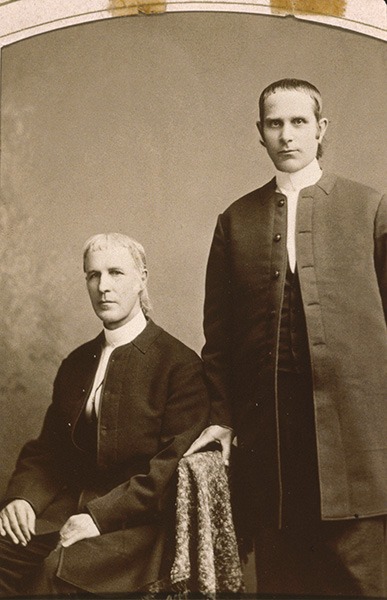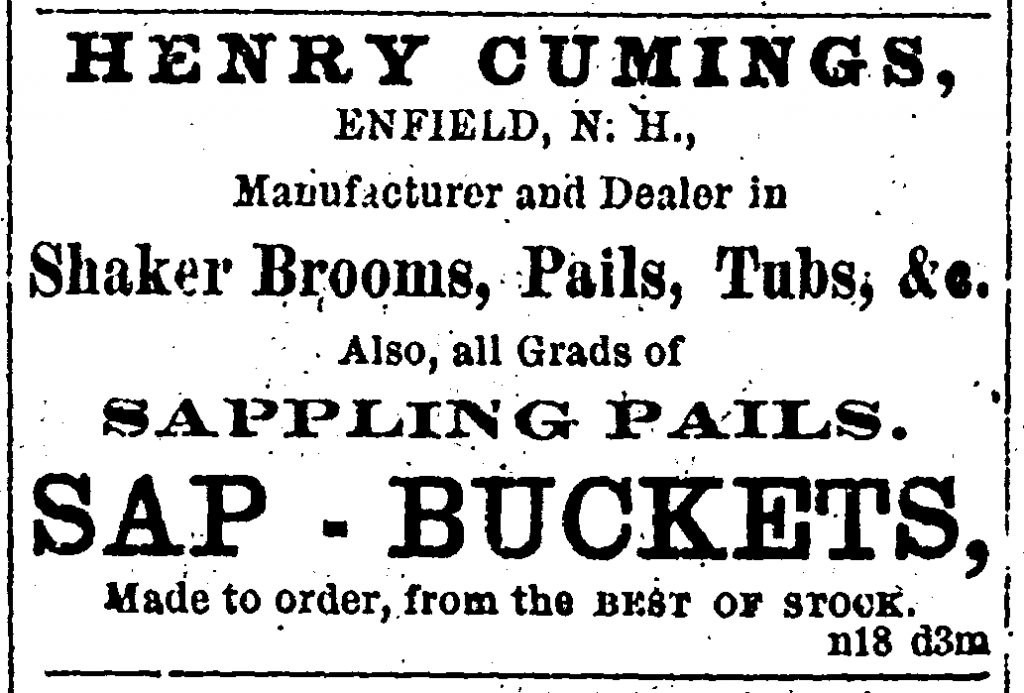
Cabinet card
Photographer unknown, ca. 1870
Collection of Canterbury Shaker Village, Canterbury, NH

Mirror and Farmer, Manchester, NH
November 25, 1872, p. 7
Elder Henry Cummings
Henry Cummings was born on June 17, 1834, in Groton, New Hampshire, the son of Edward T. and Mary (McGrath) Cummings. His parents and their five children–John, Henry, Enoch, Rosetta, and Mary Ann–entered the Shaker society at Enfield, New Hampshire, in October 1844. John, Rosetta, and Mary Ann Cummings remained Shakers for life.
Henry was 11 years old when the family joined the Shaker community. He soon moved from the North Family, the gathering order, to the boys’ house at the Church. He attended the Shaker school and was instructed by an intellectually rigorous teacher, James Hervey Elkins. Henry clearly demonstrated his intelligence and maturity during those years. At the age of 16, he was made associate caretaker of the boys. In 1853, he took over as their teacher and continued in that role until 1856.
When Shaker leadership noticed individuals of particular promise, those young people were given opportunities to distinguish themselves. In 1854 Henry was chosen to go to Maine to teach winter school at Sabbathday Lake. He went in the company of Canterbury Brother Henry Blinn, future minister in the New Hampshire bishopric, Sister Aseneth Stickney, future leader at Canterbury, and Sister Hester Adams, future eldress in the Maine Ministry. When Henry returned to Enfield he was almost immediately named associate to Elder Orville Dyer of the Church Family. He was only 22 years old.
In 1859, Henry was appointed associate elder of the North Family. Sometimes new assignments did not seem to be promotions. They were motivated, instead, by the Society’s need for good leadership in a particular place. Elder John Lyon, who had been responsible for bringing the Cummings family to Enfield, had persuaded the Ministry to allow him to retire from his forty-three years of service as Elder of the gathering order. Unfortunately, his replacements had not worked out. At age 78, John Lyon reluctantly returned to his former duties, but with the support of a young and capable associate, Henry Cummings. When Elder John died in 1862, the Ministry was uncertain whether Henry was yet ready to take full charge of the Family. In an unusual move, they appointed Trustee Caleb Dyer to be First Elder. Caleb had demonstrated remarkable skill in managing temporal affairs but had never been responsible for the spiritual well-being of young converts. He had little chance to prove himself, however, as he was murdered in July 1863. Henry Cummings succeeded Elder Caleb Dyer as First Elder of the North Family.
During the 1860s, many young believers left the Society for life in “the world.” With the leadership pool seriously depleted, it became necessary to add the job of trustee to Henry’s eldership responsibilities. His most pressing task was to retire a debt occasioned by the unscrupulous dealings of a former trustee, Brother Austin Bronson. He accomplished this by reviving and modernizing the North Family bucket and pail industry. After a decade of careful management, the debt was finally retired in 1877.
As the elder of the gathering order, Henry was the public face of Shakerism at Enfield. He conducted Sunday services to which the “world’s people” were invited. He was the person to whom persons applied for admission to the Society. Two articles that he wrote for publication, both entitled, “What Shall I Do to Be A Shaker?”, were very well received. The first appeared in the June 1877 issue of The Shaker (pp. 44-45), and the second (most comprehensive) was published in the March 1879 issue of The Shaker Manifesto (pp. 56-58).
In addition to preaching at home, Henry was a guest speaker at camp meetings and “outreach” or missionary services facilitated by friendly Protestant clergy. He also gave lively bible history lectures to local civic groups and churches. His visibility as the spokesperson for the Enfield Shakers made Henry Cummings’ apostasy in 1881 a particularly devastating blow to the community. Perhaps because they refused to see the signs, or perhaps because Henry remained fully engaged in the life of the Society until the moment of his departure, the community’s shock must have been overwhelming. Henry left in May 1881 and almost immediately married a North Family sister, Arabella Churchill. His departure and subsequent marriage were reported in newspapers from Boston to San Francisco: in Boston, the Boston Journal, May 14, 1881; in Pittsfield, Massachusetts, The Berkshire County Eagle, June 16, 1881, (p. 4); in Chicago, the Daily Inter Ocean June 27, 1881 (p.4); in San Francisco, The San Francisco Examiner, May 15, 1881 (p. 8).
Henry was willing to be interviewed by the local newspaper about his decision to renounce Shakerism. He said that he believed the movement was running out; that the Society was unable to attract and retain individuals with ability and spiritual commitment to its principles. He was still young enough to make a life for himself and his new wife “in the world” so he was anxious to leave before the movement collapsed.
Henry quickly found a job as manager of a local lumber business. This, too, was reported in the August 1, 1881 issue of The Boston Post (p. 1). Then he decided to “go west” to Grand Haven, Michigan, where his brother Enoch (also a former Enfield Shaker) promised to help him get started as a fruit farmer. But after four years he and Arabella returned to New Hampshire. Following a short stint as manager of a local creamery, the couple set up housekeeping in Enfield where they lived until his death.
Over time Henry re-established cordial relations with his Shaker siblings, and with others in the Society who had been close friends. He took up the trade of broom making, which he had learned during his time in the Enfield Shaker community. He became a strong, outspoken advocate for the causes of temperance and women’s suffrage. He donated critical funds for a public town library and joined the Methodist church. Perhaps his most lasting contribution to the story of Shakerism in Enfield was a series of articles that he wrote for the local paper, The Enfield Advocate. Henry had always valued history, and he was a gifted writer. His articles provide a detailed and nuanced view of Shaker life in the second half of the 19th century.
Henry Cummings died on October 21, 1913, in Enfield, New Hampshire. He is buried in Oak Grove Cemetery in Enfield.
Author’s Note: In Shaker documents and public records, the family name is spelled both “Cummings” and “Cumings.” Variations in spelling were fairly common in the 18th and 19th centuries. After his apostasy, Henry usually signed his name “Cumings” and his Shaker siblings more frequently used “Cummings.”
Original author: Mary Ann Haagen
Editor’s Note: Everyone interested in the Enfield, NH, Shakers will enjoy The Collected Writings of Henry Cumings (1834-1913), compiled with an introduction by Mary Ann Haagen. Collected for the first time in this volume, Henry Cumings’ writings offer the reader a lively and detailed account of the Shaker community he knew so well, and its influence on the town of Enfield, New Hampshire. 259 pages, illustrated. Available on Amazon and in the Enfield Shaker Museum Gift Shop.

